Application of Integrated BWM Fuzzy-MARCOS Approach for Coating Material Selection in Tooling Industries
Abstract
1. Introduction
- What factors and their weightage should be considered when selecting the best coating material and the evaluations of experts who are highly experienced in the coating application?
- What can a suitable integrated MADM method be used to derive the criteria weight and ranking of alternatives?
- Are obtained results reliable and derived by the integrated MADM method?
Related Work
2. The Proposed Integrated BWM Fuzzy-MADM Methodology
2.1. Fuzzy Membership Function
2.2. Integrated Fuzzy MADM Method Comprising BWM and Fuzzy-MARCOS Approach
2.2.1. BWM Method
2.2.2. Preference Evaluation of Coating Alternatives Using Fuzzy-MARCOS Approach
3. Coating Material Selection Using Integrated BWM Fuzzy-MARCOS Approach
Rank Evaluation of the Alternatives Using Fuzzy-MARCOS Approach
4. Sensitivity Analysis
4.1. Effect of Criteria Weight Change on the Ranking of Alternatives
4.2. Effect of Dynamic Matrices on the Ranking of Alternatives
4.3. Effect of Criteria Weights Derived by Different Weighting Methods
4.4. Comparison with other MADM Methods
4.5. Other Coating Material Selection Problems were Solved Using the Integrated BWM Fuzzy-MARCOS Approach
4.5.1. Hard Coating Material Selection
4.5.2. Coating Material Selection to Enhance the Heat Transfer Performance
4.5.3. Coating Material Selection for Magnesium Alloy
5. Conclusions
Supplementary Materials
Author Contributions
Funding
Institutional Review Board Statement
Informed Consent Statement
Data Availability Statement
Acknowledgments
Conflicts of Interest
Abbreviations
| MADM | Multi attributed decision making |
| BWM | Best Worst method |
| AHP | Analytic Hierarchy Process |
| STDEV | Standard deviation |
| CRITIC | Criteria Importance Through Intercriteria Correlation |
| MEREC | Method Based on the Removal Effects of Criteria |
| F-MARCOS | Fuzzy Measurement Alternatives and Ranking according to the Compromise Solution |
| F-TOPSIS | Fuzzy Technique for Order of Preference by Similarity to Ideal Solution |
| F-COPRAS | Fuzzy Complex Proportional Assessment |
| F-WASPAS | Fuzzy Weighted Aggregates Sum Product Assessment |
| F-MABAC | Fuzzy multi-attributive border approximation area comparison |
| F-CODAS | Fuzzy Combinative Distance-based Assessment |
| F-EDAS | Fuzzy Evaluation Based on Distance from Average Solution |
References
- Kheirandish, S.; Saghafian, H.; Hedjazi, J.; Momeni, M. Effect of heat treatment on microstructure of modified cast AISI D3 cold work tool steel. J. Iron Steel Res. Int. 2010, 17, 40–45. [Google Scholar] [CrossRef]
- Lesyk, D.A.; Martinez, S.; Mordyuk, B.N.; Dzhemelinskyi, V.V.; Lamikiz, A.; Prokopenko, G.I.; Milman, Y.V.; Grinkevych, K.E. Microstructure related enhancement in wear resistance of tool steel AISI D2 by applying laser heat treatment followed by ultrasonic impact treatment. Surf. Coat. Technol. 2017, 328, 344–354. [Google Scholar] [CrossRef]
- Huber, F.; Bischof, C.; Hentschel, O.; Heberle, J.; Zettl, J.; Nagulin, K.Y.; Schmidt, M. Laser beam melting and heat-treatment of 1.2343 (AISI H11) tool steel–microstructure and mechanical properties. Mater. Sci. Eng. A 2019, 42, 109–115. [Google Scholar] [CrossRef]
- Deirmina, F.; Peghini, N.; AlMangour, B.; Grzesiak, D.; Pellizzari, M. Heat treatment and properties of a hot work tool steel fabricated by additive manufacturing. Mater. Sci. Eng. A 2019, 753, 109–121. [Google Scholar] [CrossRef]
- Gonzalez-Pociño, A.; Alvarez-Antolin, F.; Asensio-Lozano, J. Improvement of adhesive wear behavior by variable heat treatment of a tool steel for sheet metal forming. Materials 2019, 2, 2831. [Google Scholar] [CrossRef]
- Kumar, S.; Maity, S.R.; Patnaik, L. A comparative study on wear behaviors of hot work and cold work tool steel with same hardness under dry sliding tribological test. Mater. Today Proc. 2021, 44, 949–954. [Google Scholar] [CrossRef]
- Díaz-Guillén, J.C.; Naeem, M.; Hdz-García, H.M.; Acevedo-Davila, J.L.; Díaz-Guillén, M.R.; Khan, M.A.; Iqbal, J.; Mtz-Enriquez, A.I. Duplex plasma treatment of AISI D2 tool steel by combining plasma nitriding (with and without white layer) and post-oxidation. Surf. Coat. Technol. 2020, 385, 125420. [Google Scholar] [CrossRef]
- Miyamoto, J.; Abraha, P. The effect of plasma nitriding treatment time on the tribological properties of the AISI H13 tool steel. Surf. Coat. Technol. 2019, 375, 15–21. [Google Scholar] [CrossRef]
- Fathallah, B.B.; Dakhli, C.E.; Terres, M.A. The effect of grinding parameters and gas nitriding depth on the grindability and surface integrity of AISI D2 tool steel. Int. J. Adv. Manuf. Technol. 2019, 104, 1449–1459. [Google Scholar] [CrossRef]
- Díaz-Guillén, J.C.; Alvarez-Vera, M.; Díaz-Guillén, J.A.; Acevedo-Davila, J.L.; Naeem, M.; Hdz-García, H.M.; Granda-Gutiérrez, E.E.; Muñoz-Arroyo, R. A hybrid plasma treatment of H13 tool steel by combining plasma nitriding and post-oxidation. J. Mater. Eng. Perform. 2018, 27, 6118–6126. [Google Scholar] [CrossRef]
- Abreu, L.H.P.; Pimentel, M.C.L.; Borges, W.F.A.; Costa, T.H.C.; Naeem, M.; Iqbal, J.; Sousa, R.R.M. Plasma nitriding of AISI M2 steel: Performance evaluation in forming tools. Surf. Eng. 2020, 36, 508–515. [Google Scholar] [CrossRef]
- Podgornik, B.; Majdic, F.; Leskovsek, V.; Vizintin, J. Improving tribological properties of tool steels through combination of deep-cryogenic treatment and plasma nitriding. Wear 2012, 288, 88–93. [Google Scholar] [CrossRef]
- Kumar, S.; Maity, S.R.; Patnaik, L. Friction and tribological behavior of bare nitrided, TiAlN and AlCrN coated MDC-K hot work tool steel. Ceram. Int. 2020, 46, 17280–17294. [Google Scholar] [CrossRef]
- Staia, M.H.; Pérez-Delgado, Y.; Sanchez, C.; Castro, A.; Le Bourhis, E.; Puchi-Cabrera, E.S. Hardness properties and high-temperature wear behavior of nitrided AISI D2 tool steel, prior and after PAPVD coating. Wear 2009, 267, 1452–1461. [Google Scholar] [CrossRef]
- Kumar, S.; Maity, S.R.; Patnaik, L. Effect of tribological process parameters on the wear and frictional behaviour of Cr-(CrN/TiN) composite coating: An experimental and analytical study. Ceram. Int. 2021, 47, 16018–16028. [Google Scholar] [CrossRef]
- Kumar, S.; Maity, S.R.; Patnaik, L. Effect of heat treatment and TiN coating on AISI O1 cold work tool steel. Mater. Today Proc. 2020, 26, 685–688. [Google Scholar] [CrossRef]
- Sousa, V.F.; Silva, F.J.G.; Alexandre, R. Study of the wear behaviour of TiAlSiN and TiAlN PVD coated tools on milling operations of pre-hardened tool steel. Wear 2021, 476, 203695. [Google Scholar] [CrossRef]
- Patel, R.D.; Bhavsar, S.N. Experimental investigation during end milling of AISI D2 tool steel using AlCrN coated tool. Mater. Today Proc. 2020, 22, 2647–2656. [Google Scholar] [CrossRef]
- Rezaei, J. Best-worst multi-criteria decision-making method. Omega 2015, 53, 49–57. [Google Scholar] [CrossRef]
- Stević, Ž.; Pamučar, D.; Puška, A. Sustainable supplier selection in healthcare industries using a new MCDM method: Measurement of alternatives and ranking according to COmpromise solution (MARCOS). Comp. Ind. Eng. 2020, 140, 106231. [Google Scholar] [CrossRef]
- Kumar, S.; Maity, S.R.; Patnaik, L. Morphology and wear behavior of monolayer TiAlN and composite AlCrN/TiAlN-coated plasma-nitrided DAC-10 tool steel. Arab. J. Sci. Eng. 2022, 47, 15519–15538. [Google Scholar] [CrossRef]
- Maity, S.R.; Chakraborty, S. Tool steel material selection using PROMETHEE II method. Int. J. Adv. Manuf. Technol. 2015, 78, 1537–1547. [Google Scholar] [CrossRef]
- Mousavi-Nasab, S.H.; Sotoudeh-Anvari, A. A comprehensive MCDM-based approach using TOPSIS, COPRAS and DEA as an auxiliary tool for material selection problems. Mater. Des. 2017, 121, 237–253. [Google Scholar] [CrossRef]
- Niu, J.; Huang, C.; Li, C.; Zou, B.; Xu, L.; Wang, J.; Liu, Z. A comprehensive method for selecting cutting tool materials. Int. J. Adv. Manuf. Technol. 2020, 110, 229–240. [Google Scholar] [CrossRef]
- Podgornik, B.; Hogmark, S.; Sandberg, O. Proper coating selection for improved galling performance of forming tool steel. Wear 2006, 261, 15–21. [Google Scholar] [CrossRef]
- Saber-Samandari, S.; Berndt, C.C.; Gross, K.A. Selection of the implant and coating materials for optimized performance by means of nanoindentation. Acta Biomater. 2011, 7, 874–881. [Google Scholar] [CrossRef]
- Athanasopoulos, G.; Riba, C.R.; Athanasopoulou, C. A decision support system for coating selection based on fuzzy logic and multi-criteria decision making. Expert Syst. Appl. 2009, 36, 10848–10853. [Google Scholar] [CrossRef]
- Mogra, A.; Pandey, P.K.; Gupta, K.K. Influence of surface wettability and selection of coating material for enhancement of heat transfer performance. Mater. Today Proc. 2021, 44, 4433–4438. [Google Scholar] [CrossRef]
- Pahan, F.; Dambhare, S.; Mali, A.; Nawale, S. Implementation of multi-criteria decision making for selection of coating material on AISI 4140 steel. Int. Res. J. Eng. Technol. 2018, 5, 1514–1517. [Google Scholar]
- Prasad, R.V.; Rajesh, R.; Thirumalaikumarasamy, D. Selection of coating material for magnesium alloy using Fuzzy AHP-TOPSIS. Sādhanā 2020, 45, 23. [Google Scholar] [CrossRef]
- Robinson, P.; Matthews, A.; Swift, K.G.; Franklin, S. A computer knowledge-based system for surface coating and material selection. Surf. Coat. Technol. 1993, 62, 662–668. [Google Scholar] [CrossRef]
- Firojkhan, P.; Kadam, N.; Dambhare, S.G. Selection of Coating and Nitriding Process for AISI 4140 Steel Material to Enhance Tribological Properties. In Advanced Engineering Optimization through Intelligent Techniques; Springer: Singapore, 2020; pp. 463–473. [Google Scholar] [CrossRef]
- Chauhan, A.; Vaish, R. Hard coating material selection using multi-criteria decision making. Mater. Des. 2013, 44, 40–245. [Google Scholar] [CrossRef]
- Petković, D.; Madić, M.; Radovanović, M.; Janković, P. Application of Recently Developed MCDM Methods for Materials Selection. Appl. Mech. Mater. 2015, 809, 1468–1473. [Google Scholar] [CrossRef]
- Adesina, A.Y.; Al-Badour, F.A.; Gasem, Z.M. Wear resistance performance of AlCrN and TiAlN coated H13 tools during friction stir welding of A2124/SiC composite. J. Manuf. Process. 2018, 33, 111–125. [Google Scholar] [CrossRef]
- Das, K.; Alphonsa, J.; Ghosh, M.; Ghanshyam, J.; Rane, R.; Mukherjee, S. Influence of pretreatment on surface behavior of duplex plasma treated AISI H13 tool steel. Surf. Interf. 2017, 8, 206–213. [Google Scholar] [CrossRef]
- Kara, L.; Asl, H.G.; Karadayi, Ö. The effect of TiN, TiAlN, CrAlN, and TiAlN/TiSiN coatings on the wear properties of AISI H13 steel at room temperature. Surf. Rev. Lett. 2019, 26, 1950063. [Google Scholar] [CrossRef]
- Souza, P.S.; Santos, A.J.; Cotrim, M.A.; Abrão, A.M.; Câmara, M.A. Analysis of the surface energy interactions in the tribological behavior of ALCrN and TIAlN coatings. Tribol. Int. 2020, 146, 106206. [Google Scholar] [CrossRef]
- Beake, B.D.; Endrino, J.L.; Kimpton, C.; Fox-Rabinovich, G.S.; Veldhuis, S.C. Elevated temperature repetitive micro-scratch testing of AlCrN, TiAlN and AlTiN PVD coatings. Int. J. Refract. Hard Mater. 2017, 69, 215–226. [Google Scholar] [CrossRef]
- Dumkum, C.; Jaritngam, P.; Tangwarodomnukun, V. Surface characteristics and machining performance of TiAlN-, TiN-and AlCrN-coated tungsten carbide drills. Proc. Inst. Mech. Eng. Part B J. Eng. Manuf. 2019, 233, 1075–1086. [Google Scholar] [CrossRef]
- Jokar, K.; Elmkhah, H.; Fattah-alhosseini, A.; Babaei, K.; Zolriasatein, A. Comparison of the wear and corrosion behavior between CrN and AlCrN coatings deposited by Arc-PVD method. Mater. Res. Exp. 2019, 6, 116426. [Google Scholar] [CrossRef]
- Özkan, D.; Erarslan, Y.; Sulukan, E. Tribological behavior of TiAlN, AlTiN, and AlCrN coatings at boundary lubricating condition. Tribol. Lett. 2018, 66, 152. [Google Scholar] [CrossRef]
- Chandrashekhar, A.; Kabadi, V.R.; Bhide, R. Scratch wear resistance of TiALN and AlCrN coated EN-353 steel. J. Mater. Sci. Eng. 2016, 5, 1–9. [Google Scholar] [CrossRef]
- Kundu, P.; Görçün, Ö.F.; Küçükönder, H. Medical device selection in private hospitals by integrated fuzzy MCGDM methods: A case study in choosing MRI (Magnetic Resonance Imaging) system. J. Oper. Res. Soc. 2021, 73, 2059–2079. [Google Scholar] [CrossRef]
- Salih, M.M.; Zaidan, B.B.; Zaidan, A.A. Survey on fuzzy TOPSIS state-of-the-art between 2007 and 2017. Comput. Oper. Res. 2019, 104, 207–227. [Google Scholar] [CrossRef]
- Ecer, F.; Pamucar, D. Sustainable supplier selection: A novel integrated fuzzy best worst method (F-BWM) and fuzzy CoCoSo with Bonferroni (CoCoSo’B) multi-criteria model. J. Clean. Prod. 2020, 266, 121981. [Google Scholar] [CrossRef]
- Fallahpour, A.; Nayeri, S.; Sheikhalishahi, M. A hyper-hybrid fuzzy decision-making framework for the sustainable-resilient supplier selection problem: A case study of Malaysian Palm oil industry. Environ. Sci. Pollut. Res. 2021, 1–21. [Google Scholar] [CrossRef]
- Ulutas, A.; Topal, A.; Bakhat, R. An application of fuzzy integrated model in green supplier selection. Math. Probl. Eng. 2019, 2019, 4256359. [Google Scholar] [CrossRef]
- Maghsoodi, A.I.; Mosavat, M.; Hafezalkotob, A.; Hafezalkotob, A. Hybrid hierarchical fuzzy group decision-making based on information axioms and BWM: Prototype design selection. Comput. Ind. Eng. 2019, 127, 788–804. [Google Scholar] [CrossRef]
- Yadav, G.; Mangla, S.K.; Luthra, S.; Jakhar, S. Hybrid BWM-ELECTRE-based decision framework for effective offshore outsourcing adoption: A case study. Int. J. Prod. Res. 2018, 56, 6259–6278. [Google Scholar] [CrossRef]
- Yadav, G.; Seth, D.; Desai, T.N. Application of hybrid framework to facilitate lean six sigma implementation: A manufacturing company case experience. Prod. Plan Control. 2018, 29, 185–201. [Google Scholar] [CrossRef]
- Kumar, S.; Maity, S.R.; Patnaik, L. Effect of annealing on structural, mechanical and tribological properties of Cr-(CrN/TiAlN) coating. Adv. Mater. Process. Technol. 2021, 8, 1569–1582. [Google Scholar] [CrossRef]
- Kumar, S.; Maity, S.R.; Patnaik, L. Relation between mechanical and tribological properties of plasma nitrided and TiCrN coated YXR-7 tool steel. In AIP Conference Proceedings; AIP Publishing LLC: Melville, NY, USA, 2021; Volume 2369, p. 020033. [Google Scholar] [CrossRef]
- Kumar, S.; Maity, S.R.; Patnaik, L. Wear assessment of Cr2O3-/TiAlN-coated DAC-10 tool steel against steel and Al2O3 counterbodies. Int. J. Appl. Ceram. Technol. 2022, 19, 1678–1690. [Google Scholar] [CrossRef]
- Jeon, S.; Van Tyne, C.J.; Lee, H. Degradation of TiAlN coatings by the accelerated life test using pulsed laser ablation. Ceram. Int. 2014, 40, 8677–8685. [Google Scholar] [CrossRef]
- Aperador, W.; Delgado, A.; Caicedo, J.C. Analysis of Corrosion Degradation of TiCrN Coatings Subjected to High Temperatures. Int. J. Electrochem. Sci. 2017, 12, 4502–4514. [Google Scholar] [CrossRef]
- Meindlhumer, M.; Klima, S.; Jäger, N.; Stark, A.; Hruby, H.; Mitterer, C.; Keckes, J.; Daniel, R. Stress-controlled decomposition routes in cubic AlCrN films assessed by in-situ high-temperature high-energy grazing incidence transmission X-ray diffraction. Sci. Rep. 2019, 9, 18027. [Google Scholar] [CrossRef]
- Puška, L.A.; Kozarević, S.; Stević, Ž. A new way of applying interval fuzzy logic in group decision making for supplier selection. Econ. Comput. Econ. Cybern. Stud. Res. 2018, 52, 217–234. [Google Scholar] [CrossRef]
- Maity, S.R.; Chakraborty, S. Grinding wheel abrasive material selection using fuzzy TOPSIS method. Mater. Manuf. Process. 2013, 28, 408–417. [Google Scholar] [CrossRef]
- Alao, M.A.; Ayodele, T.R.; Ogunjuyigbe, A.S.O.; Popoola, O.M. Multi-criteria decision based waste to energy technology selection using entropy-weighted TOPSIS technique: The case study of Lagos, Nigeria. Energy 2020, 201, 117675. [Google Scholar] [CrossRef]
- Anitha, J.; Das, R. Optimization of EDM Process Parameters Using Standard Deviation and Multi-objective Optimization on the Basis of Simple Ratio Analysis (MOOSRA). In Intelligent Manufacturing and Energy Sustainability; Springer: Berlin/Heidelberg, Germany, 2020; pp. 655–662. [Google Scholar]
- Ho, W. Integrated analytic hierarchy process and its applications—A literature review. Eur. J. Oper. Res. 2008, 186, 211–228. [Google Scholar] [CrossRef]
- Peng, X.; Krishankumar, R.; Ravichandran, K.S. A novel interval-valued fuzzy soft decision-making method based on CoCoSo and CRITIC for intelligent healthcare management evaluation. Soft Comput. 2021, 25, 4213–4241. [Google Scholar] [CrossRef]
- Keshavarz-Ghorabaee, M.; Amiri, M.; Zavadskas, E.K.; Turskis, Z.; Antucheviciene, J. Determination of Objective Weights Using a New Method Based on the Removal Effects of Criteria (MEREC). Symmetry 2021, 13, 525. [Google Scholar] [CrossRef]
- Turskis, Z.; Zavadskas, E.K.; Antucheviciene, J. A hybrid model based on fuzzy AHP and fuzzy WASPAS for construction site selection. Int. J. Comput. Commun. Control. 2015, 10, 113–128. [Google Scholar] [CrossRef]
- Alkan, Ö.; Albayrak, Ö.K. Ranking of renewable energy sources for regions in Turkey by fuzzy entropy based fuzzy COPRAS and fuzzy MULTIMOORA. Renew. Energy 2020, 162, 712–726. [Google Scholar] [CrossRef]
- Liang, W.; Zhao, G.; Wu, H.; Dai, B. Risk assessment of rockburst via an extended MABAC method under fuzzy environment. Tunn. Undergr. Space. Technol. 2019, 83, 533–544. [Google Scholar] [CrossRef]
- Yalçın, N.; Yapıcı Pehlivan, N. Application of the fuzzy CODAS method based on fuzzy envelopes for hesitant fuzzy linguistic term sets: A case study on a personnel selection problem. Symmetry 2019, 11, 493. [Google Scholar] [CrossRef]
- Polat, G.; Bayhan, H.G. Selection of HVAC-AHU system supplier with environmental considerations using Fuzzy EDAS method. Int. J. Constr. Manag. 2020, 22, 1863–1871. [Google Scholar] [CrossRef]
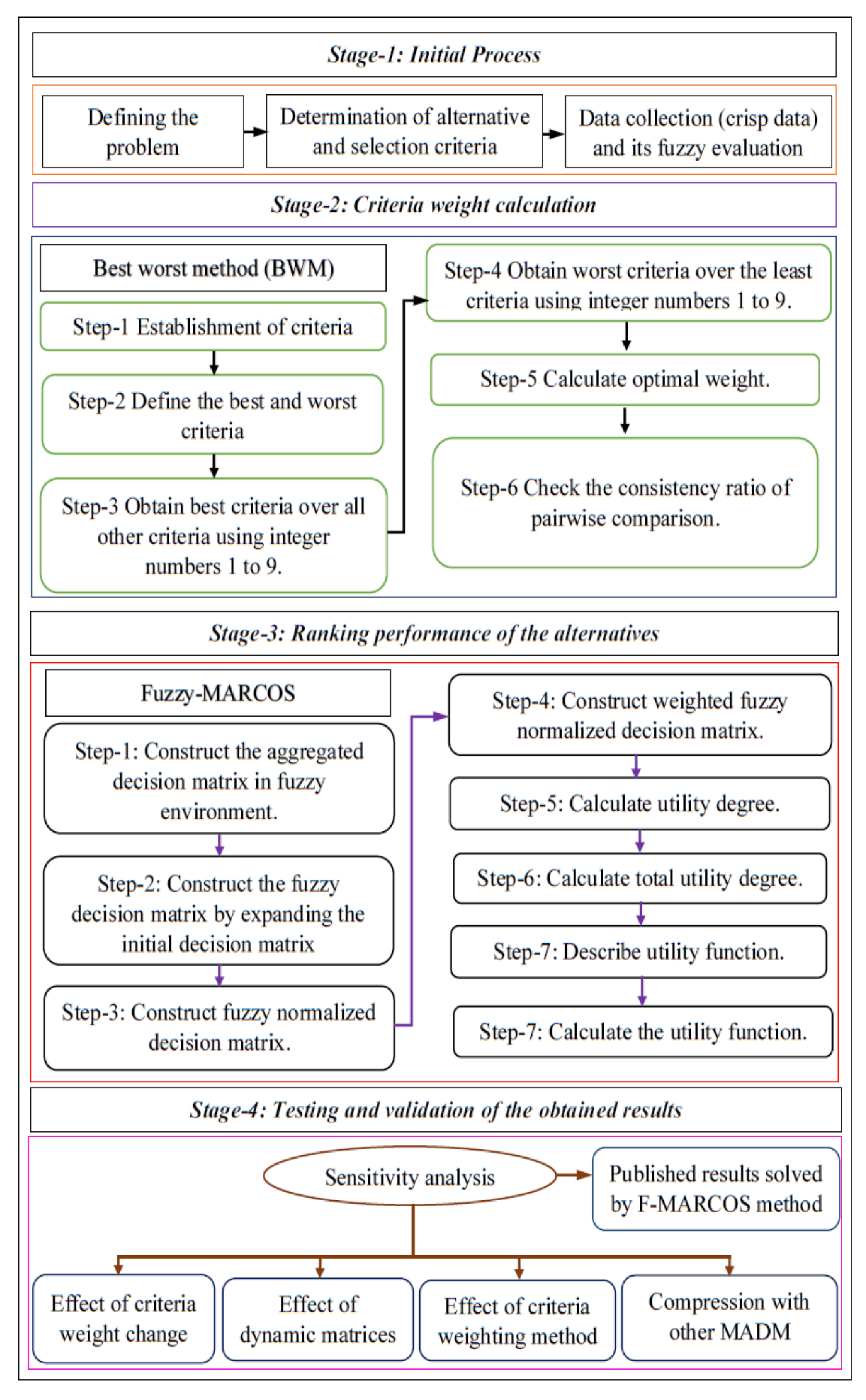
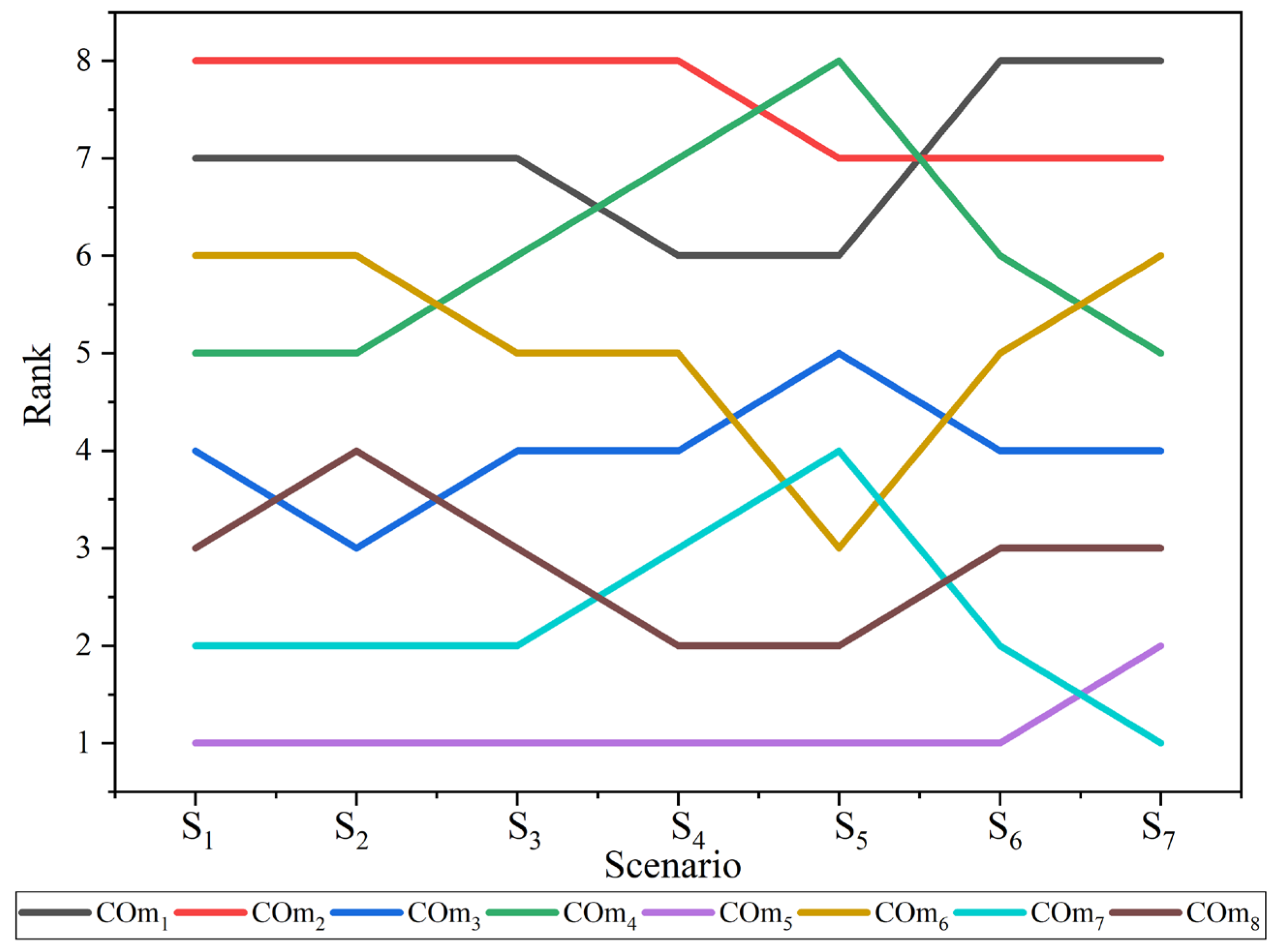
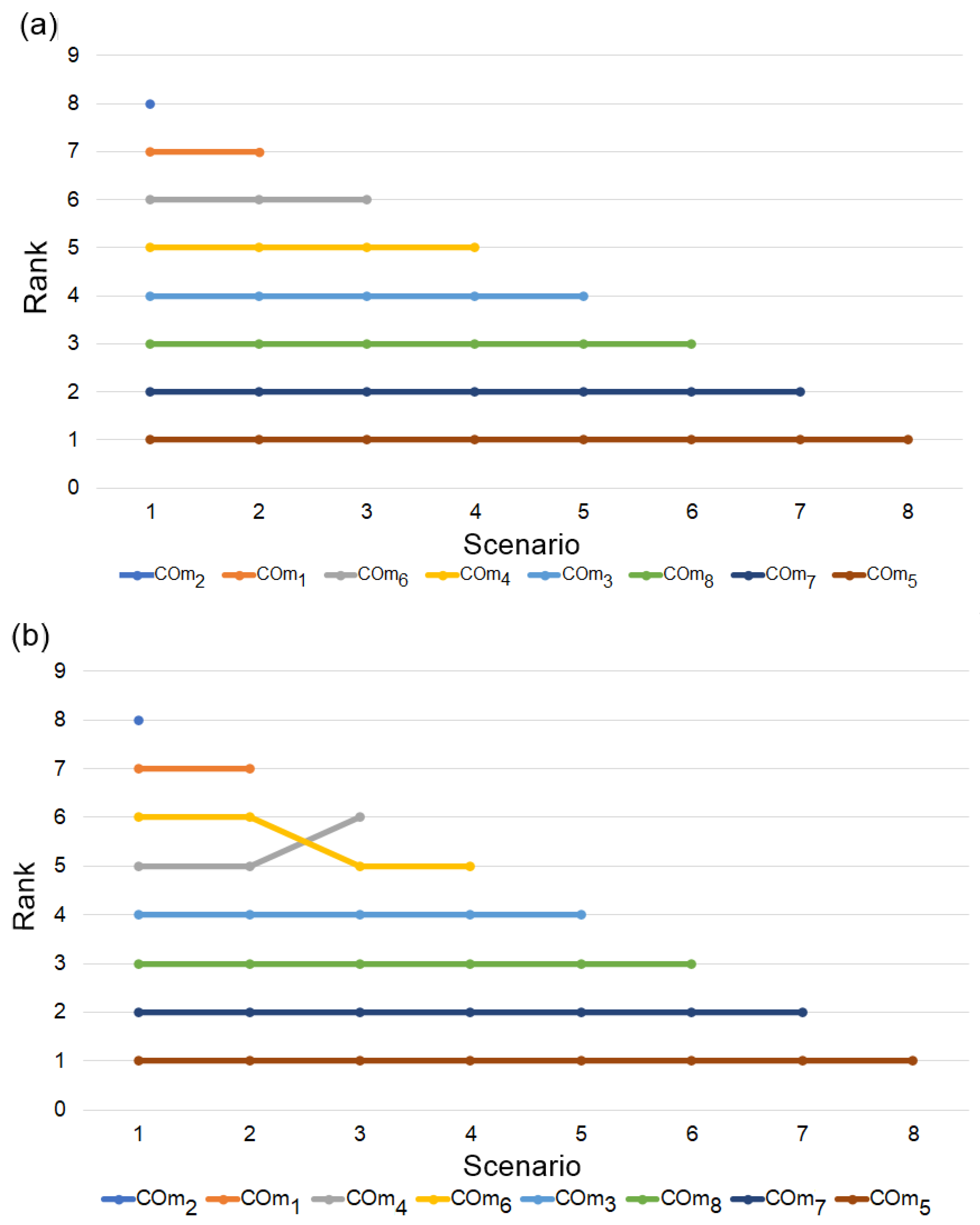
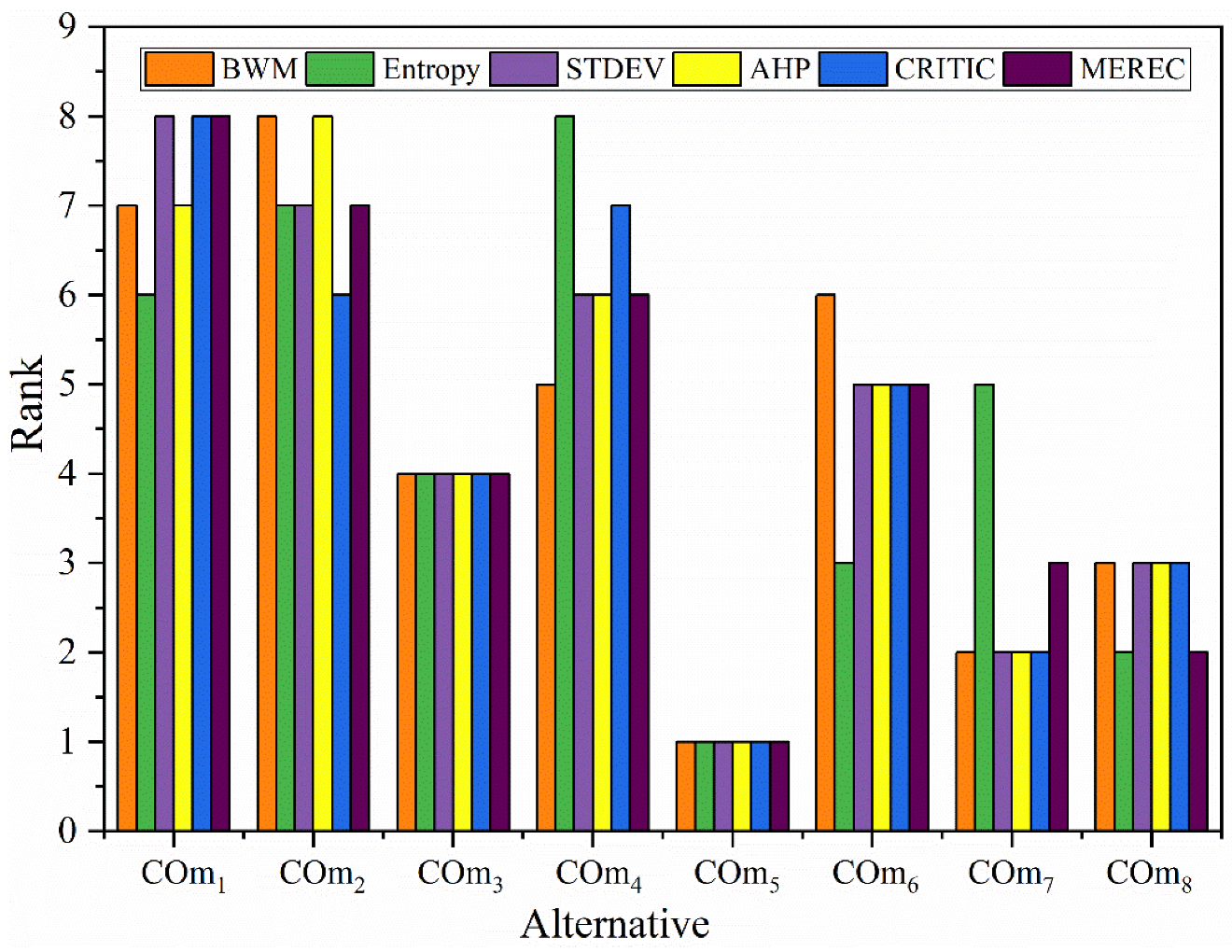
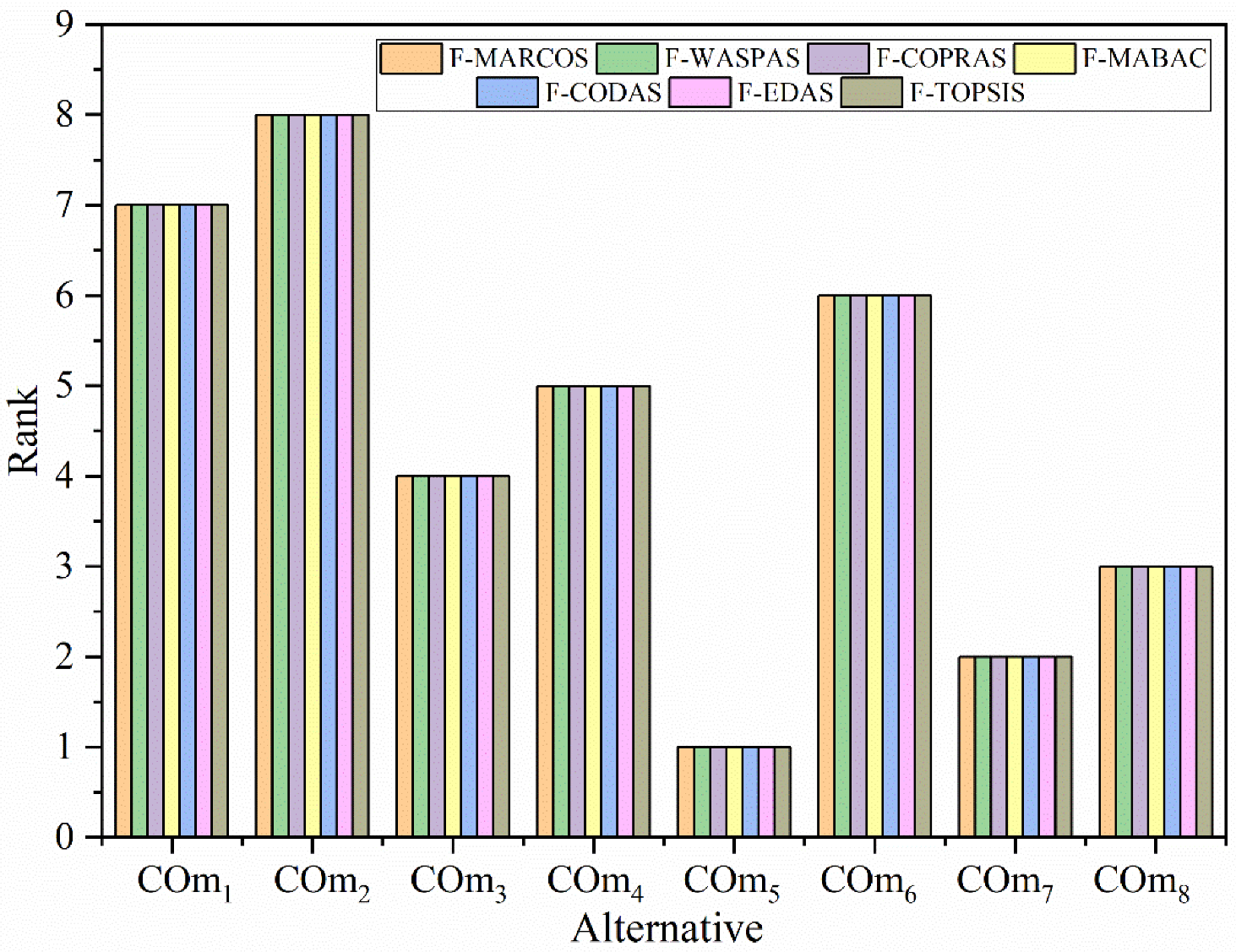
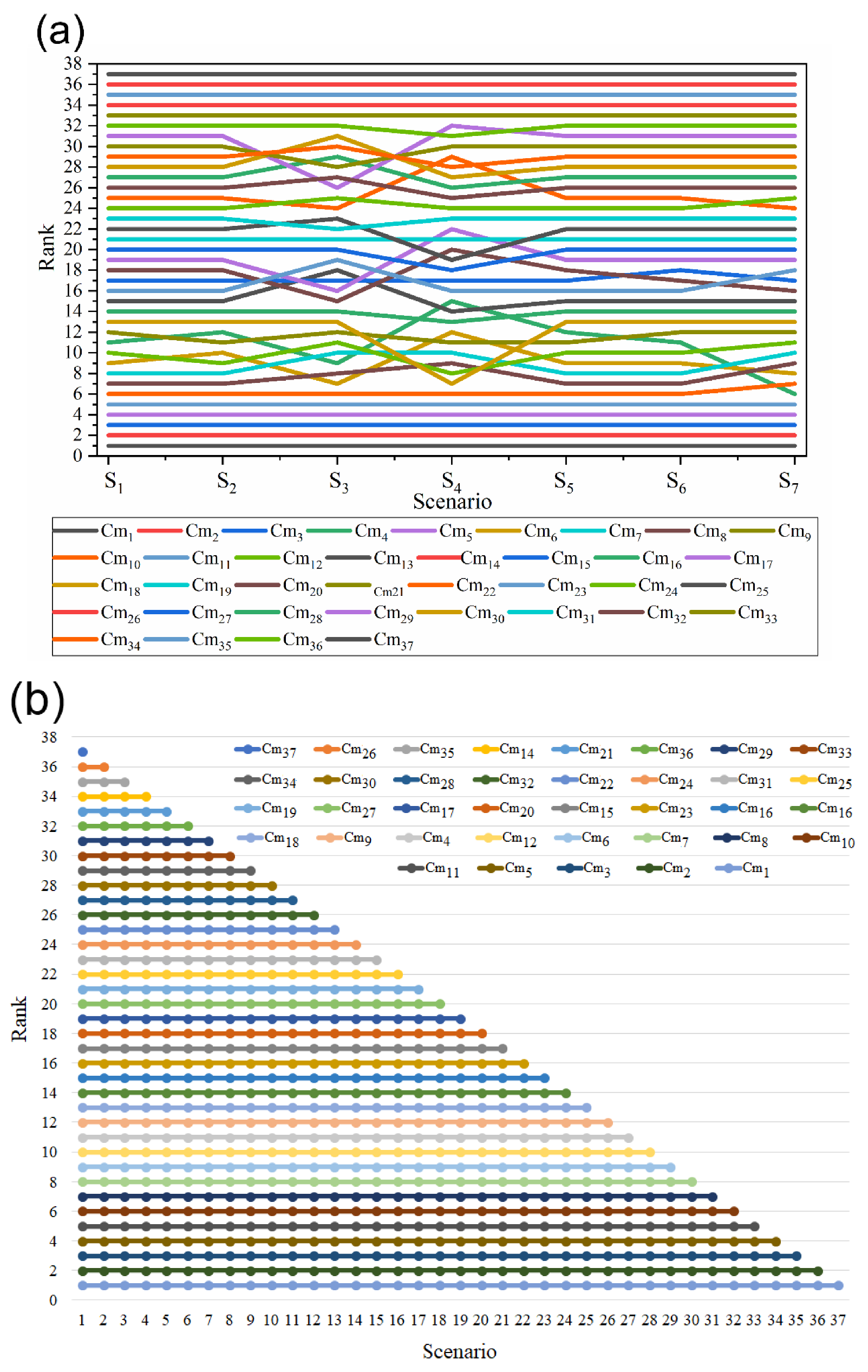
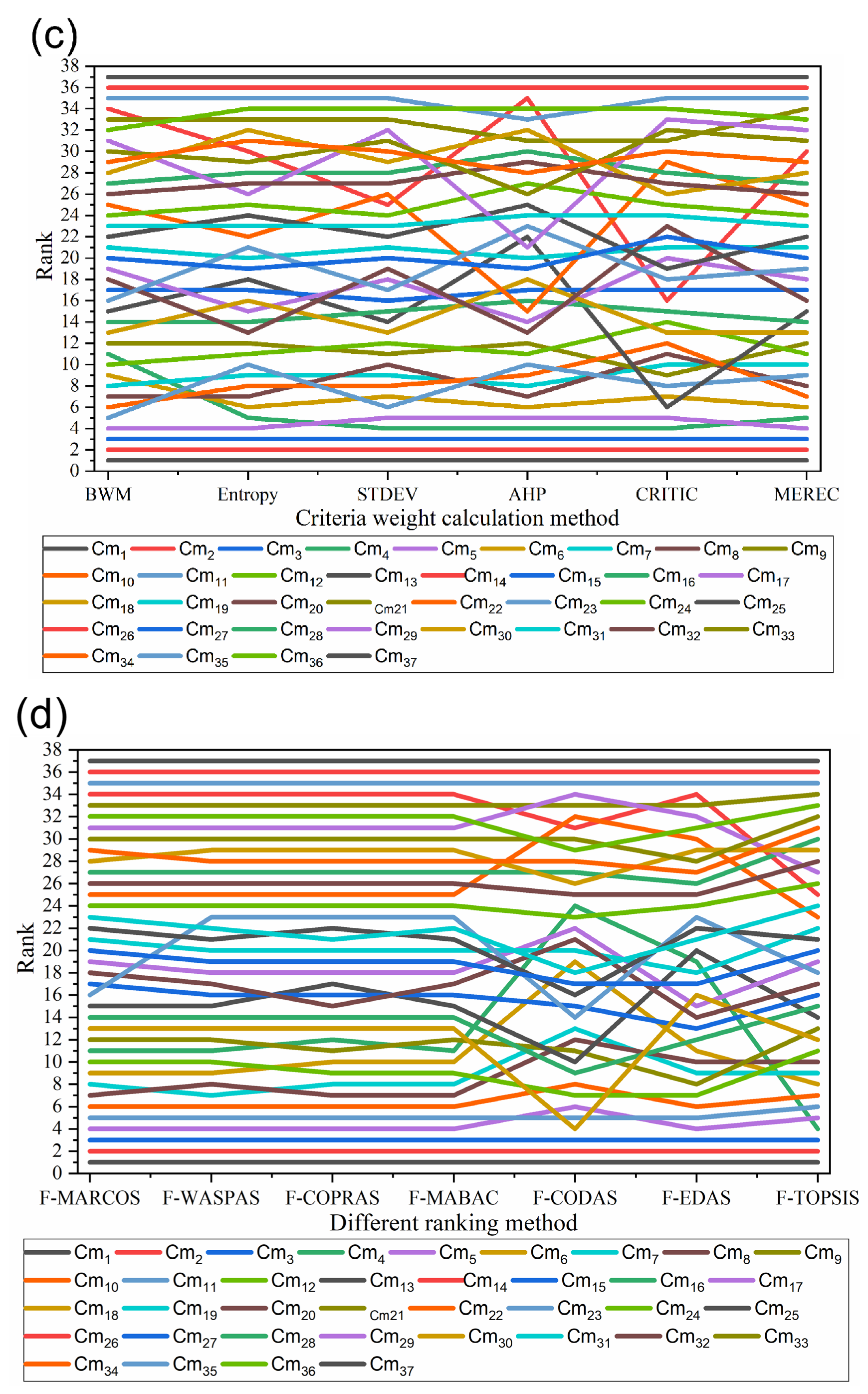
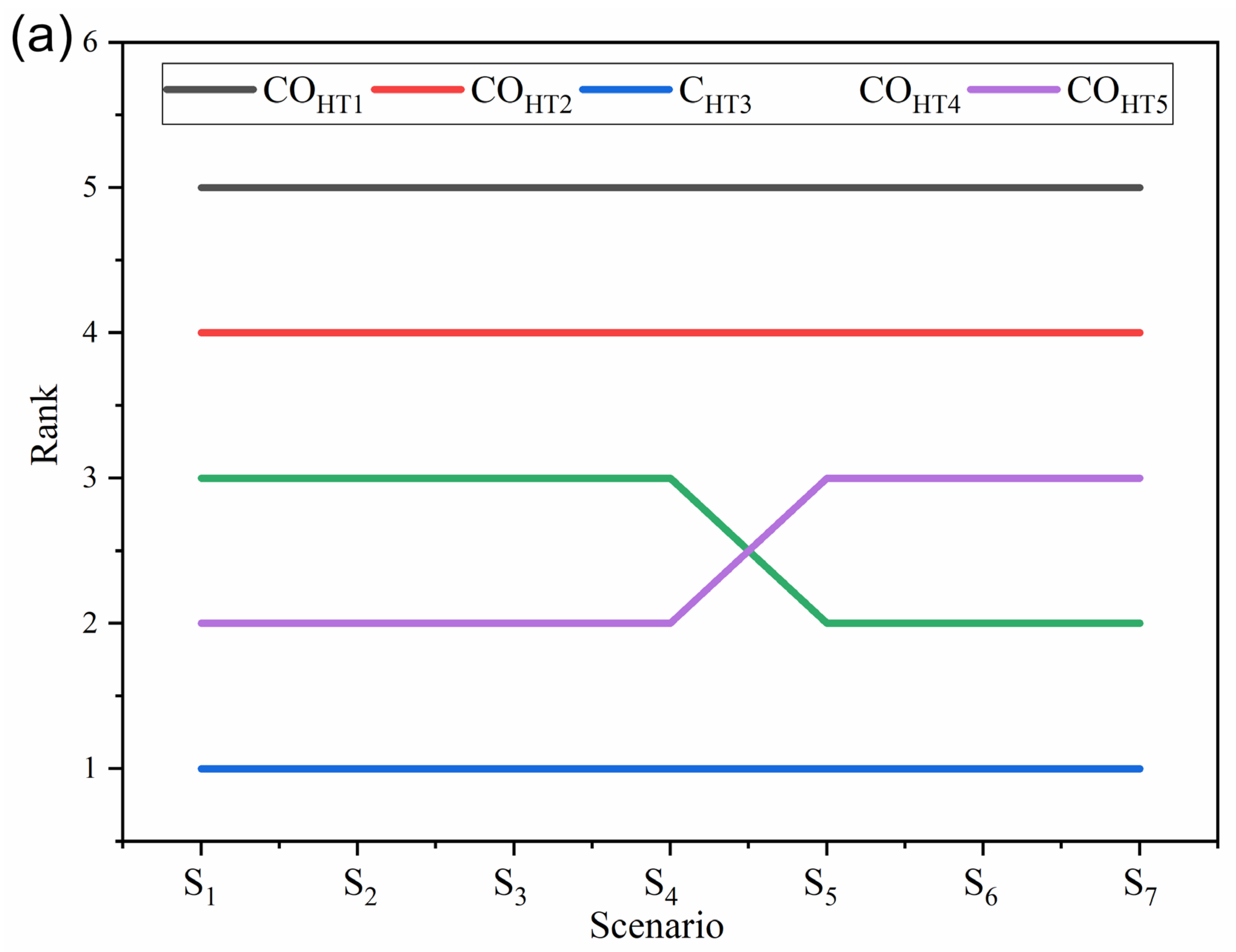
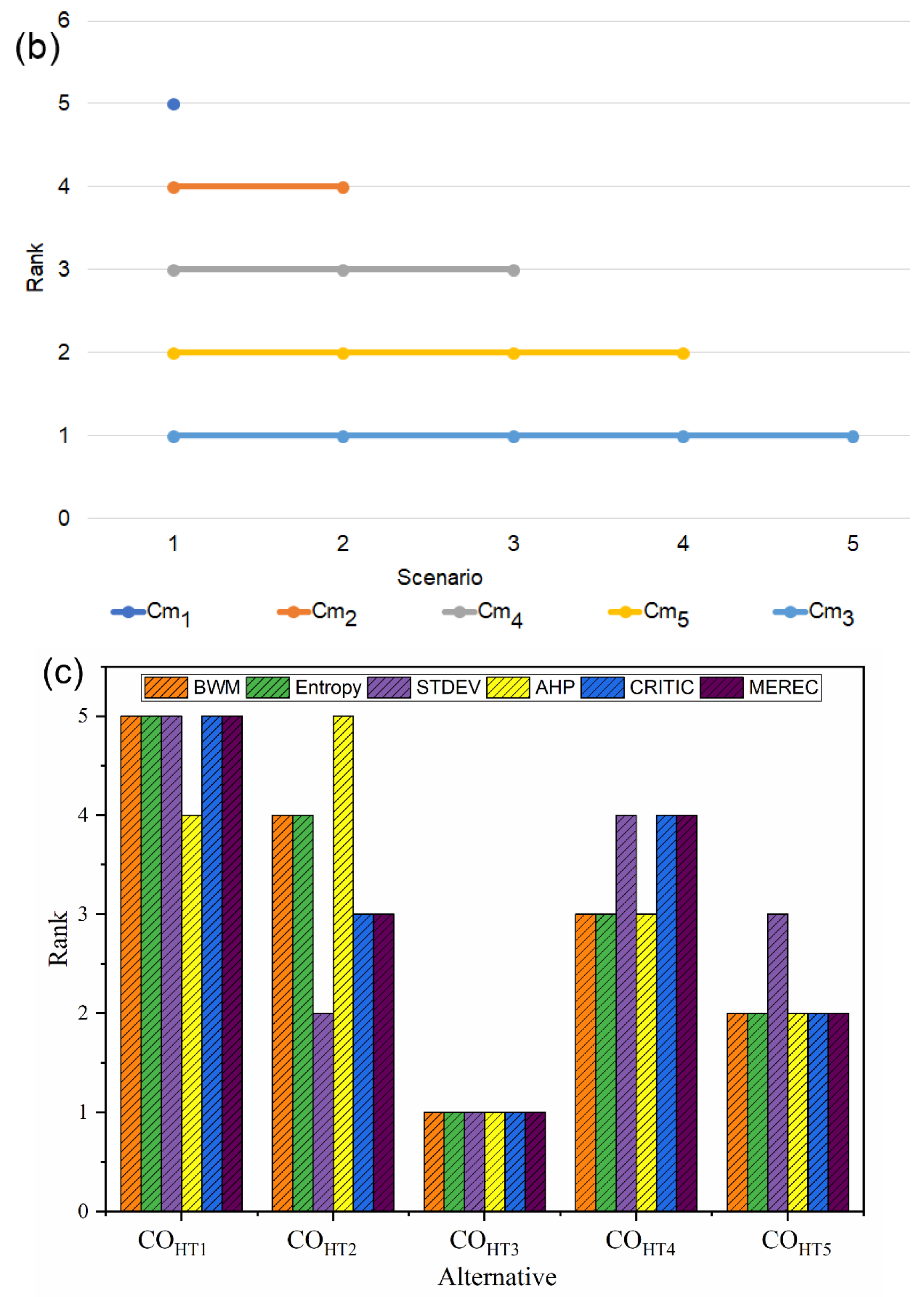
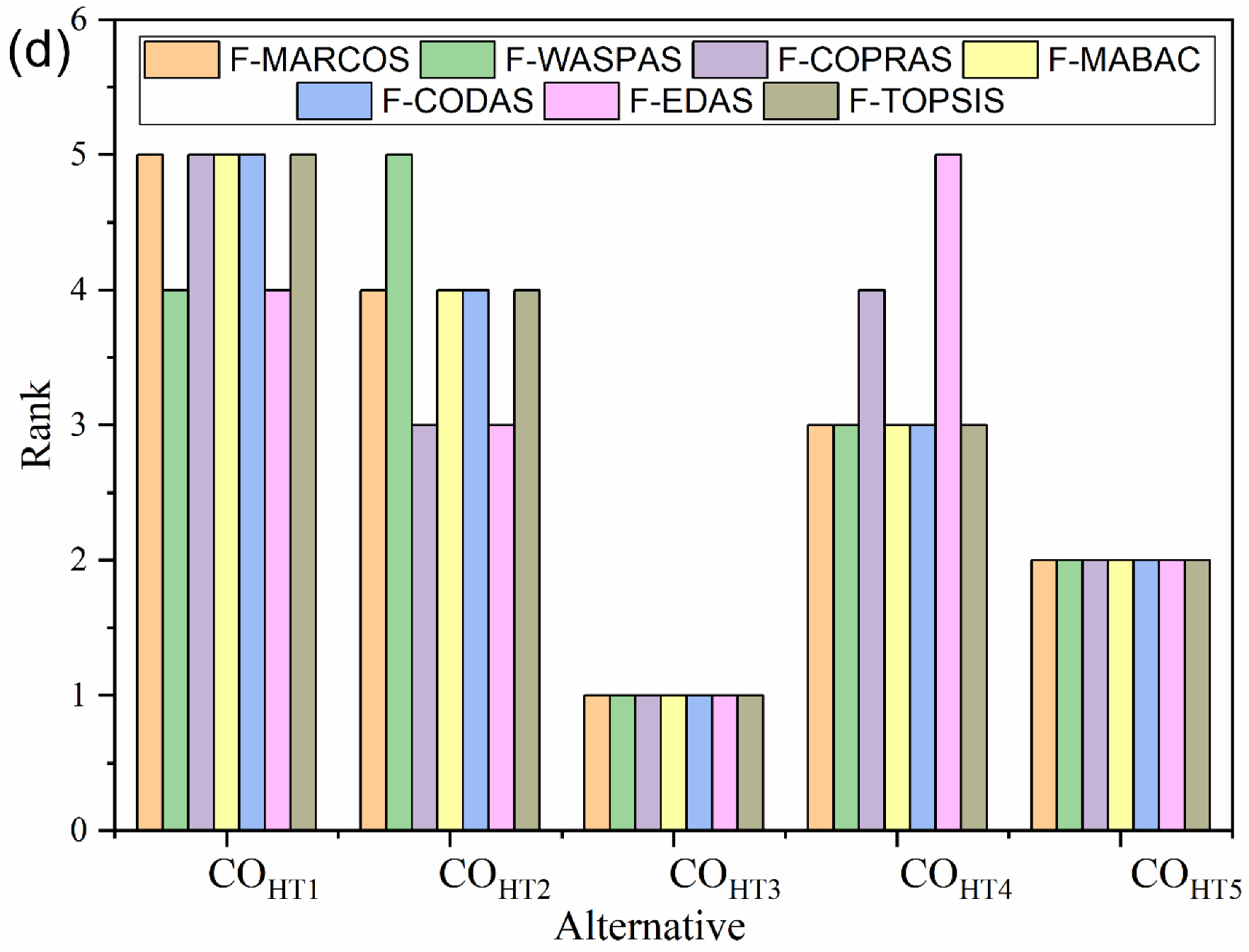
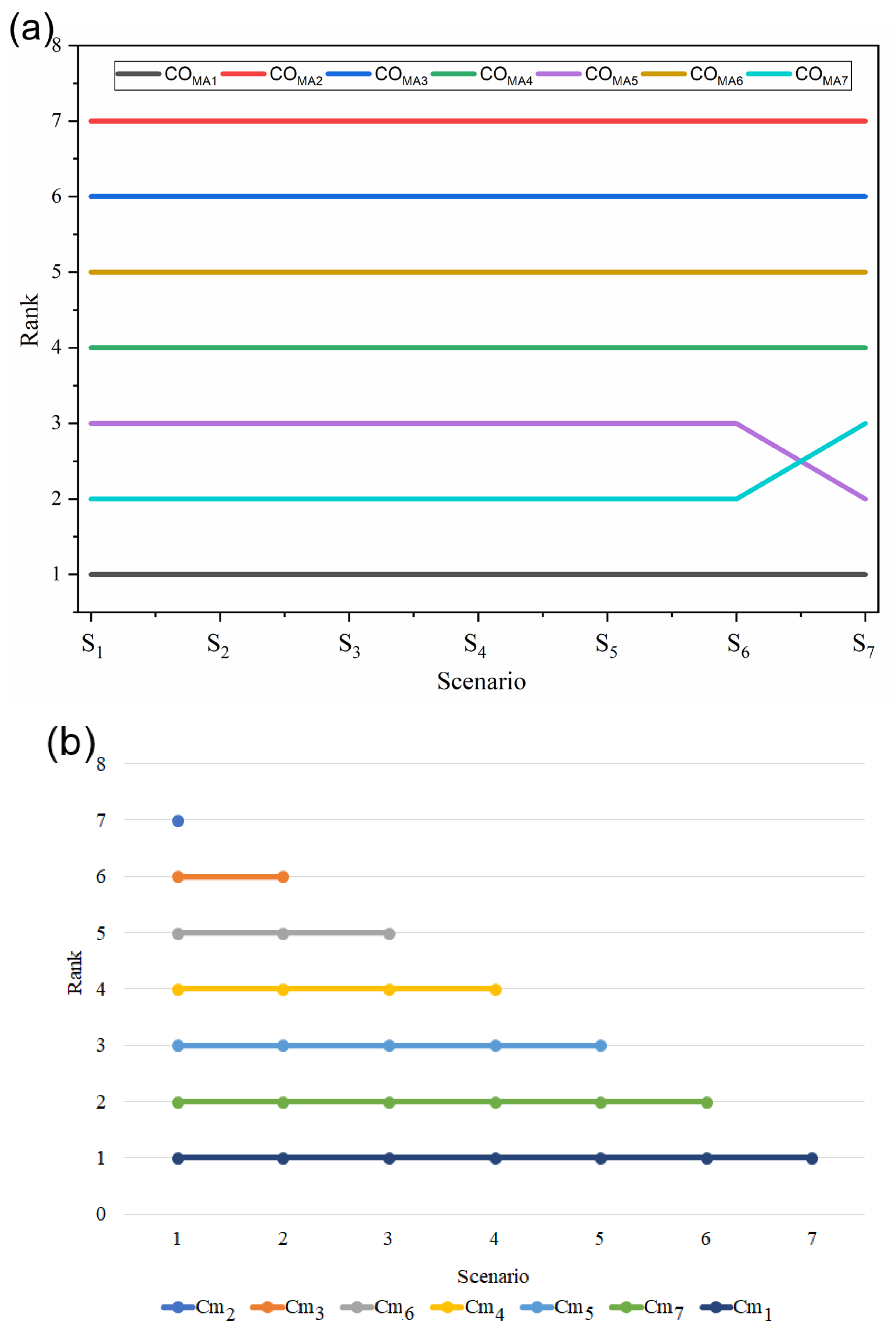
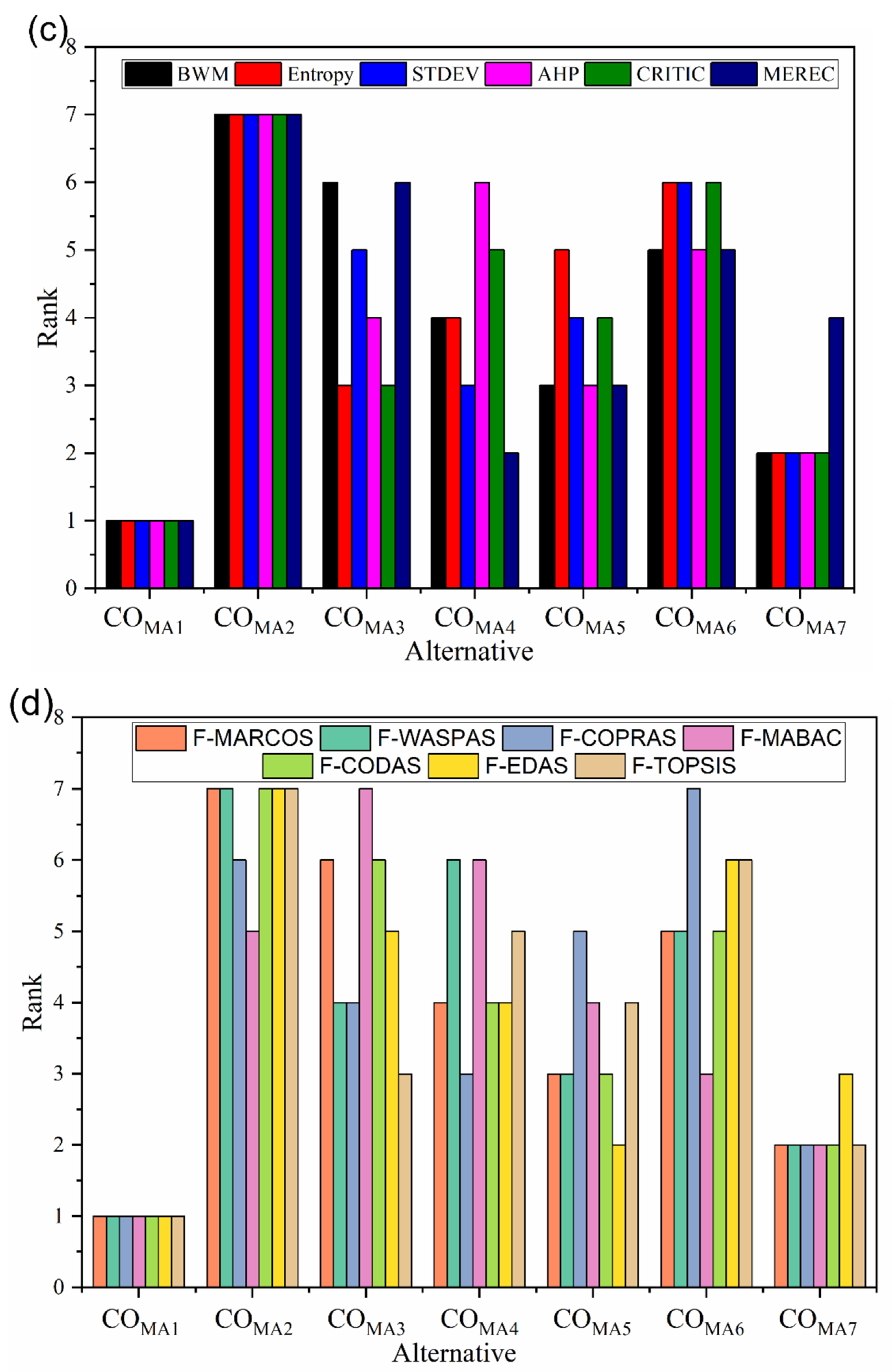
| Coating Materials Alternative | Symbol | Composition (at. %) | ||||
|---|---|---|---|---|---|---|
| Ti | N | Cr | Al | O | ||
| TiN | COm1 | 38.63 | 61.37 | - | - | - |
| TiCrN | COm2 | 27.97 | 51.21 | 20.82 | - | - |
| TiAlN | COm3 | 26.83 | 48.08 | - | 25.14 | - |
| AlCrN | COm4 | - | 47.82 | 19.99 | 32.19 | - |
| AlCrN/TiAlN | COm5 | 20.31 | 56.11 | 2.32 | 20.66 | - |
| Cr-(CrN/TiN) | COm6 | 36.96 | 58.73 | 4.31 | - | - |
| Cr-(CrN/TiAlN) | COm7 | 22.53 | 56.18 | 3.5 | 17.79 | - |
| Cr2O3/TiAlN | COm8 | 24.33 | 48.52 | 5.57 | 16.76 | 4.82 |
| Properties of Coating Materials (Criteria) | Symbol |
|---|---|
| Indentation hardness (HIT, in Gpa) | CCO1 |
| Young’s modulus (EIT, in GPa) | CCO2 |
| Wear resistance (HIT/EIT) | CCO3 |
| Plastic Deformation ((HIT)3/(EIT)2, in GPa) | CCO4 |
| Strain hardening exponent (n) | CCO5 |
| Coefficient of thermal expansion (K−1, ×10−6) | CCO6 |
| Surface roughness (Ra, in µm) | CCO7 |
| Coefficient of friction (CoF) | CCO8 |
| Wear rate (K, in mm3/Nm) | CCO9 |
| Alternative | CCO1 | CCO2 | CCO3 | CCO4 | CCO5 |
|---|---|---|---|---|---|
| COm1 | (18, 21, 24) | (362, 372, 382) | (0.050, 0.057, 0.063) | (0.045, 0.067, 0.095) | (0.31, 0.32, 0.33) |
| COm2 | (17, 20, 23) | (318, 330, 342) | (0.053, 0.061, 0.067) | (0.049, 0.074, 0.104) | (0.29, 0.3, 0.31) |
| COm3 | (31, 35, 39) | (350, 359, 368) | (0.089, 0.098, 0.106) | (0.243, 0.333, 0.438) | (0.39, 0.4, 0.41) |
| COm4 | (27, 32, 37) | (361, 368, 375) | (0.075, 0.087, 0.099) | (0.151, 0.242, 0.360) | (0.33, 0.35, 0.37) |
| COm5 | (35, 38, 41) | (409, 423, 437) | (0.086, 0.090, 0.094) | (0.256, 0.313, 0.361) | (0.43, 0.44, 0.45) |
| COm6 | (26, 28, 30) | (339, 347, 355) | (0.077, 0.081, 0.085) | (0.153, 0.182, 0.214) | (0.32, 0.34, 0.36) |
| COm7 | (37, 40, 43) | (358, 367, 376) | (0.103, 0.109, 0.114) | (0.395, 0.475, 0.562) | (0.41, 0.42, 0.43) |
| COm8 | (33, 38, 43) | (374, 387, 400) | (0.088, 0.098, 0.108) | (0.257, 0.366, 0.497) | (0.35, 0.36, 0.37) |
| Alternative | CCO6 | CCO7 | CCO8 | CCO9 | |
| COm1 | (8.14, 9.35, 10.56) | (0.24, 0.26, 0.28) | (0.3, 0.32, 0.34) | (11.72, 12.46, 13.2) | |
| COm2 | (3.03, 3.21, 3.39) | (0.28, 0.31, 0.34) | (0.42, 0.43, 0.44) | (9.24, 9.73, 10.22) | |
| COm3 | (6.6, 7.5, 8.4) | (0.28, 0.32, 0.36) | (0.52, 0.55, 0.58) | (6.11, 6.62, 7.13) | |
| COm4 | (5.2, 5.9, 6.6) | (0.37, 0.39, 0.41) | (0.55, 0.57, 0.59) | (7.24, 7.87, 8.5) | |
| COm5 | (6.6, 7.5, 8.4) | (0.21, 0.24, 0.27) | (0.48, 0.49, 0.5) | (6.2, 6.61, 7.02) | |
| COm6 | (8.14, 9.35, 10.56) | (0.22, 0.27, 0.32) | (0.3, 0.33, 0.36) | (8.41, 8.94, 9.47) | |
| COm7 | (6.6, 7.5, 8.4) | (0.39, 0.42, 0.45) | (0.46, 0.48, 0.5) | (6.1, 6.49, 6.88) | |
| COm8 | (6.6, 7.5, 8.4) | (0.28, 0.31, 0.34) | (0.4, 0.43, 0.46) | (7.43, 7.9, 8.37) | |
| Criteria | CCO1 | CCO2 | CCO3 | CCO4 | CCO5 | CCO6 | CCO7 | CCO8 | CCO9 |
|---|---|---|---|---|---|---|---|---|---|
| Weight | 0.254 | 0.151 | 0.076 | 0.061 | 0.152 | 0.027 | 0.1 | 0.076 | 0.103 |
| Ksi * | 0.048 | ||||||||
| Alternative | ||||
| AAI | (0.487, 0.528, 0.570) | |||
| COm1 | (0.571, 0.617, 0.664) | (1.003, 1.169, 1.365) | (0.571, 0.659, 0.758) | (1.574, 1.828, 2.123) |
| COm2 | (0.548, 0.593, 0.639) | (0.962, 1.123, 1.313) | (0.548, 0.633, 0.729) | (1.511, 1.757, 2.041) |
| COm3 | (0.717, 0.780, 0.848) | (1.258, 1.478, 1.742) | (0.717, 0.833, 0.967) | (1.974, 2.311, 2.709) |
| COm4 | (0.638, 0.706, 0.778) | (1.120, 1.338, 1.599) | (0.638, 0.754, 0.888) | (1.758, 2.092, 2.487) |
| COm5 | (0.801, 0.853, 0.908) | (1.405, 1.616, 1.865) | (0.801, 0.911, 1.035) | (2.206, 2.527, 2.900) |
| COm6 | (0.649, 0.700, 0.757) | (1.140, 1.325, 1.555) | (0.649, 0.747, 0.863) | (1.789, 2.073, 2.419) |
| COm7 | (0.786, 0.834, 0.885) | (1.379, 1.580, 1.818) | (0.786, 0.891, 1.009) | (2.165, 2.471, 2.827) |
| COm8 | (0.725, 0.796, 0.871) | (1.273, 1.508, 1.790) | (0.725, 0.850, 0.994) | (1.998, 2.358, 2.784) |
| AI | (0.877, 0.936, 1.000) | = 2.536 | ||
| Alternative | Rank | |||||||
|---|---|---|---|---|---|---|---|---|
| COm1 | (0.225, 0.260, 0.299) | (0.395, 0.461, 0.538) | 1.174 | 0.661 | 0.261 | 0.463 | 0.145 | 7 |
| COm2 | (0.216, 0.250, 0.287) | (0.379, 0.443, 0.518) | 1.128 | 0.635 | 0.250 | 0.445 | 0.133 | 8 |
| COm3 | (0.283, 0.329, 0.381) | (0.496, 0.583, 0.687) | 1.485 | 0.836 | 0.330 | 0.586 | 0.245 | 4 |
| COm4 | (0.252, 0.297, 0.350) | (0.442, 0.527, 0.631) | 1.345 | 0.757 | 0.299 | 0.530 | 0.196 | 5 |
| COm5 | (0.316, 0.359, 0.408) | (0.554, 0.637, 0.735) | 1.622 | 0.913 | 0.360 | 0.640 | 0.299 | 1 |
| COm6 | (0.256, 0.295, 0.340) | (0.449, 0.523, 0.613) | 1.333 | 0.750 | 0.296 | 0.526 | 0.192 | 6 |
| COm7 | (0.310, 0.351, 0.398) | (0.544, 0.623, 0.717) | 1.586 | 0.893 | 0.352 | 0.626 | 0.284 | 2 |
| COm8 | (0.286, 0.335, 0.392) | (0.502, 0.595, 0.706) | 1.516 | 0.853 | 0.336 | 0.598 | 0.256 | 3 |
| Scenarios | Criteria Weightage | ||||||||
|---|---|---|---|---|---|---|---|---|---|
| CCO1 | CCO2 | CCO3 | CCO4 | CCO5 | CCO6 | CCO7 | CCO8 | CCO9 | |
| Scenario 1 (S1) | 0.254 | 0.151 | 0.076 | 0.061 | 0.152 | 0.027 | 0.1 | 0.076 | 0.103 |
| Scenario 2 (S2) | 0.149 | 0.138 | 0.078 | 0.066 | 0.284 | 0.020 | 0.062 | 0.080 | 0.123 |
| Scenario 3 (S3) | 0.110 | 0.039 | 0.055 | 0.190 | 0.094 | 0.068 | 0.300 | 0.047 | 0.097 |
| Scenario 4 (S4) | 0.110 | 0.018 | 0.087 | 0.190 | 0.019 | 0.038 | 0.400 | 0.078 | 0.060 |
| Scenario 5 (S5) | 0.016 | 0.018 | 0.099 | 0.190 | 0.019 | 0.038 | 0.400 | 0.160 | 0.060 |
| Scenario 6 (S6) | 0.111 | 0.111 | 0.111 | 0.111 | 0.111 | 0.111 | 0.111 | 0.111 | 0.111 |
| Scenario 7 (S7) | 0.500 | 0.063 | 0.063 | 0.063 | 0.063 | 0.063 | 0.063 | 0.063 | 0.063 |
| Weighing Methods | CCO1 | CCO2 | CCO3 | CCO4 | CCO5 | CCO6 | CCO7 | CCO8 | CCO9 |
|---|---|---|---|---|---|---|---|---|---|
| Entropy | 0.091 | 0.008 | 0.068 | 0.119 | 0.026 | 0.055 | 0.494 | 0.060 | 0.080 |
| STDEV | 0.125 | 0.113 | 0.112 | 0.113 | 0.113 | 0.085 | 0.112 | 0.118 | 0.109 |
| AHP | 0.241 | 0.092 | 0.081 | 0.141 | 0.125 | 0.035 | 0.173 | 0.064 | 0.048 |
| CRITIC | 0.089 | 0.082 | 0.087 | 0.085 | 0.082 | 0.148 | 0.154 | 0.191 | 0.084 |
| MEREC | 0.115 | 0.030 | 0.103 | 0.089 | 0.052 | 0.090 | 0.325 | 0.078 | 0.117 |
| Coating Materials Alternatives | Symbol | Coating Materials Alternatives | Symbol | Coating Materials Alternatives | Symbol |
|---|---|---|---|---|---|
| C | Cm1 | CrN | Cm14 | HfO2 | Cm26 |
| BN | Cm2 | ZrB2 | Cm15 | CrB2 | Cm27 |
| B4C | Cm3 | NbB2 | Cm16 | ZrN | Cm28 |
| Si3N4 | Cm4 | Al2O3 | Cm17 | TiO2 | Cm29 |
| VC | Cm5 | W2B5 | Cm18 | TaC | Cm30 |
| SiB6 | Cm6 | VB2 | Cm19 | TiN | Cm31 |
| LaB6 | Cm7 | Cr3C2 | Cm20 | Mo2C | Cm32 |
| ZrC | Cm8 | AlN | Cm21 | BeO | Cm33 |
| SiC | Cm9 | ZrO2 | Cm22 | VN | Cm34 |
| TiC | Cm10 | Mo2B5 | Cm23 | ThO2 | Cm35 |
| TiB2 | Cm11 | NbC | Cm24 | NbN | Cm36 |
| B | Cm12 | TaB2 | Cm25 | MgO | Cm37 |
| WC | Cm13 |
| Properties of Coating Materials (Criteria) | Symbol |
|---|---|
| Hardness (HIT, in Gpa) | C1 |
| Young’s modulus (EIT, in GPa) | C2 |
| Wear resistance (HIT/EIT) | C3 |
| Plastic Deformation ((HIT)3/(EIT)2, in GPa) | C4 |
| Strain hardening exponent (n) | C5 |
| Alternative | f(Ki) | F-MARCOS | TOPSIS [33] | COPRAS [34] | WASPAS [34] | Alternative | f(Ki) | F-MARCOS | TOPSIS [33] | COPRAS [34] | WASPAS [34] |
|---|---|---|---|---|---|---|---|---|---|---|---|
| Cm1 | 0.123 | 1 | 1 | 1 | 1 | Cm20 | 0.014 | 18 | 20 | 19 | 19 |
| Cm2 | 0.056 | 2 | 2 | 2 | 2 | Cm21 | 0.006 | 33 | 21 | 32 | 33 |
| Cm3 | 0.034 | 3 | 3 | 3 | 3 | Cm22 | 0.010 | 25 | 22 | 26 | 28 |
| Cm4 | 0.018 | 11 | 4 | 4 | 5 | Cm23 | 0.014 | 16 | 23 | 20 | 18 |
| Cm5 | 0.024 | 4 | 5 | 5 | 4 | Cm24 | 0.010 | 24 | 24 | 25 | 24 |
| Cm6 | 0.019 | 9 | 6 | 6 | 7 | Cm25 | 0.012 | 22 | 25 | 23 | 22 |
| Cm7 | 0.020 | 8 | 7 | 7 | 9 | Cm26 | 0.004 | 36 | 26 | 36 | 36 |
| Cm8 | 0.020 | 7 | 8 | 8 | 10 | Cm27 | 0.014 | 20 | 27 | 22 | 21 |
| Cm9 | 0.018 | 12 | 9 | 11 | 11 | Cm28 | 0.009 | 27 | 28 | 27 | 27 |
| Cm10 | 0.021 | 6 | 10 | 10 | 8 | Cm29 | 0.007 | 31 | 29 | 33 | 32 |
| Cm11 | 0.022 | 5 | 11 | 9 | 6 | Cm30 | 0.008 | 28 | 30 | 29 | 29 |
| Cm12 | 0.019 | 10 | 12 | 12 | 12 | Cm31 | 0.012 | 23 | 31 | 24 | 23 |
| Cm13 | 0.015 | 15 | 13 | 13 | 13 | Cm32 | 0.009 | 26 | 32 | 28 | 26 |
| Cm14 | 0.006 | 34 | 14 | 18 | 25 | Cm33 | 0.008 | 30 | 33 | 31 | 30 |
| Cm15 | 0.014 | 17 | 15 | 16 | 16 | Cm34 | 0.008 | 29 | 34 | 30 | 31 |
| Cm16 | 0.017 | 14 | 16 | 15 | 15 | Cm35 | 0.005 | 35 | 35 | 35 | 35 |
| Cm17 | 0.014 | 19 | 17 | 17 | 17 | Cm36 | 0.007 | 32 | 36 | 34 | 34 |
| Cm18 | 0.018 | 13 | 18 | 14 | 14 | Cm37 | 0.003 | 37 | 37 | 37 | 37 |
| Cm19 | 0.013 | 21 | 19 | 21 | 20 | ||||||
| Coating Materials Alternatives | Symbol |
|---|---|
| Al2O3 | COHT1 |
| TiO2 | COHT2 |
| CNT | COHT3 |
| SiO2 | COHT4 |
| ZnO | COHT5 |
| Properties of Hard Coating (Criteria) | Symbol |
|---|---|
| Cost | CHT1 |
| Contact angle | CHT2 |
| Coefficient of thermal expansion (K−1, ×10−6) | CHT3 |
| Thickness | CHT4 |
| Alternative | f(Ki) | F- MARCOS | AHP-VIKOR [28] | E-VIKOR [28] | AHP-COPRAS [28] | E-COPRAS [28] | AHP-TOPSIS [28] | E-TOPSIS [28] |
|---|---|---|---|---|---|---|---|---|
| COHT1 | 0.042 | 5 | 4 | 4 | 4 | 4 | 2 | 2 |
| COHT2 | 0.051 | 4 | 5 | 2 | 5 | 5 | 1 | 3 |
| COHT3 | 0.169 | 1 | 1 | 5 | 1 | 1 | 5 | 1 |
| COHT4 | 0.096 | 3 | 3 | 1 | 2 | 3 | 4 | 4 |
| COHT5 | 0.124 | 2 | 2 | 3 | 3 | 2 | 3 | 5 |
| Coating Materials Alternatives | Symbol |
|---|---|
| 316SS | COMA1 |
| Al2O3-TiO2 | COMA2 |
| Zn/Al-Mn Composite | COMA3 |
| Si3N4 | COMA4 |
| NiCrBSi | COMA5 |
| CoNiCrAlY | COMA6 |
| Ni-Zn-Cu-P/Ni-P duplex | COMA7 |
| Properties of Hard Coating (Criteria) | Symbol |
|---|---|
| Quantitative | CMA1 |
| Qualitative | CMA2 |
| Cost | CMA3 |
| Quality | CMA4 |
| Coating structure | CMA5 |
| Risk factor | CMA6 |
| Alternative | f(Ki) | F-MARCOS | TOPSIS [30] |
|---|---|---|---|
| COMA1 | 0.308 | 1 | 1 |
| COMA2 | 0.227 | 7 | 7 |
| COMA3 | 0.230 | 6 | 4 |
| COMA4 | 0.245 | 4 | 3 |
| COMA5 | 0.249 | 3 | 5 |
| COMA6 | 0.237 | 5 | 6 |
| COMA7 | 0.304 | 2 | 2 |
Publisher’s Note: MDPI stays neutral with regard to jurisdictional claims in published maps and institutional affiliations. |
© 2022 by the authors. Licensee MDPI, Basel, Switzerland. This article is an open access article distributed under the terms and conditions of the Creative Commons Attribution (CC BY) license (https://creativecommons.org/licenses/by/4.0/).
Share and Cite
Kumar, S.; Bhaumik, S.; Patnaik, L.; Maity, S.R.; Paleu, V. Application of Integrated BWM Fuzzy-MARCOS Approach for Coating Material Selection in Tooling Industries. Materials 2022, 15, 9002. https://doi.org/10.3390/ma15249002
Kumar S, Bhaumik S, Patnaik L, Maity SR, Paleu V. Application of Integrated BWM Fuzzy-MARCOS Approach for Coating Material Selection in Tooling Industries. Materials. 2022; 15(24):9002. https://doi.org/10.3390/ma15249002
Chicago/Turabian StyleKumar, Sunil, Shubrajit Bhaumik, Lokeswar Patnaik, Saikat Ranjan Maity, and Viorel Paleu. 2022. "Application of Integrated BWM Fuzzy-MARCOS Approach for Coating Material Selection in Tooling Industries" Materials 15, no. 24: 9002. https://doi.org/10.3390/ma15249002
APA StyleKumar, S., Bhaumik, S., Patnaik, L., Maity, S. R., & Paleu, V. (2022). Application of Integrated BWM Fuzzy-MARCOS Approach for Coating Material Selection in Tooling Industries. Materials, 15(24), 9002. https://doi.org/10.3390/ma15249002










